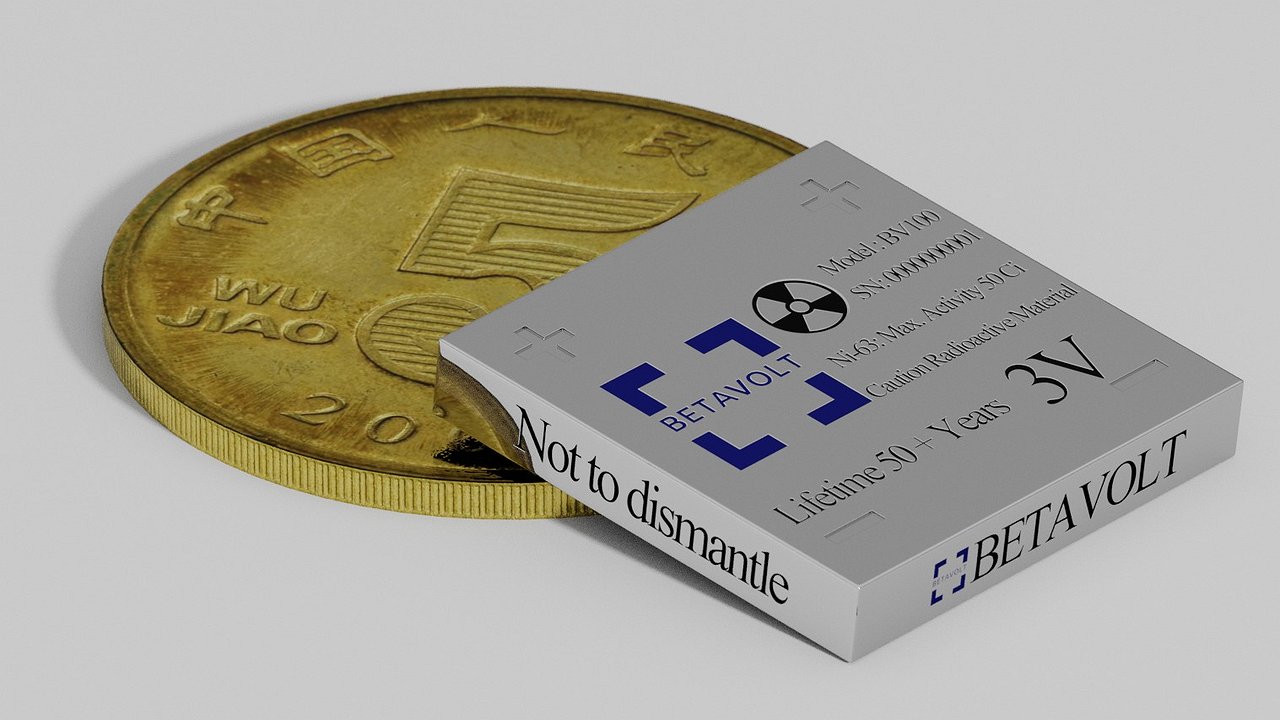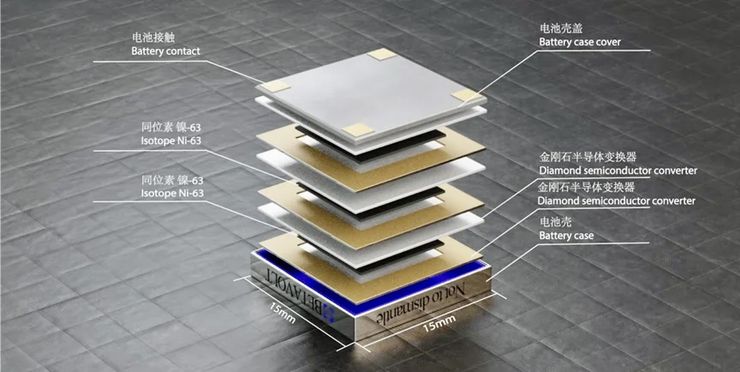The biggest problem with any electric car is the need to constantly charge the batteries. This takes a long time anyway and is sometimes even completely impossible due to the lack of good infrastructure. And now a Chinese startup has announced the creation of a working prototype of an energy cell that uses nuclear energy. The mass introduction of this technology will make it possible to equip electric cars with power sources that will last for years and decades.
The previously unknown Chinese company Betavolt has announced the creation of a miniature nuclear battery called BV100. It generates electricity using the decay of the nickel isotope Ni−63. It emits microdoses of beta radiation or electrons. The Chinese development consists of the thinnest layers of nickel alternating with layers of diamond semiconductor. In this way, the electrons released by the isotope are ‘recycled’ in the semiconductor wafers, creating an electric current.
The energy consumption of the BV100 is at an astonishing level of 3300 MWh with dimensions of only 15x15x15 mm. The prototype produces a voltage of 3V and a power of up to 0.1W. The energy density in the battery is approximately 10 times higher than in the most advanced modern lithium battery. The estimated battery life is approximately 50 years. After this time, any Ni-63 present will turn into regular copper. Betavolt claims that BV100 is completely harmless to humans. It has no external radioactive radiation. Operating temperatures – from −60°C to 120°C.
The current battery prototypes are fully tested and are being prepared for mass production in a 1-volt version in 2025.
The startup’s engineers plan to provide the use of their power supplies as part of the assemblies. This will enable greater energy generation for use in smartphones, unmanned aerial vehicles, medical equipment, space travel and, apparently, electric vehicles.
Breathtaking, isn’t it? And now it’s time to tell the reader that in 2017, Rosatom’s Electrochemical Plant (ECP) in Zelenogorsk (Krasnoyarsk Territory) announced its plans to begin industrial production of the nickel-63 radioisotope for… the creation of “atomic batteries”. ”! In the same message, the company’s management said that the estimated time frame for the implementation of the Russian project is 2020-2023. And the Federal State Unitary Enterprise Research Institute NPO “Luch” is involved in this issue.
Almost seven years have passed since then. But so far no one has heard of the Russian battery. Despite the fact that Zelenogorsk ECP is virtually the only enterprise in the world that can produce and enrich Ni−63.
Meanwhile, in the same area, some unknown Chinese showed up suspiciously quickly. This suggests that the success of their technological breakthrough is not so much related to the talents of the developers, but to serious achievements in the field of industrial espionage. Any Russian counterintelligence agent will confirm to you that Chinese industrial and military spies have been very closely involved in enterprises of the Russian military-industrial complex and scientific organizations of the Russian Federation since the collapse of the USSR…
The previously unknown Chinese company Betavolt has announced the creation of a miniature nuclear battery called BV100. It generates electricity using the decay of the nickel isotope Ni−63. It emits microdoses of beta radiation or electrons. The Chinese development consists of the thinnest layers of nickel alternating with layers of diamond semiconductor. In this way, the electrons released by the isotope are ‘recycled’ in the semiconductor wafers, creating an electric current.
The energy consumption of the BV100 is at an astonishing level of 3300 MWh with dimensions of only 15x15x15 mm. The prototype produces a voltage of 3V and a power of up to 0.1W. The energy density in the battery is approximately 10 times higher than in the most advanced modern lithium battery. The estimated battery life is approximately 50 years. After this time, any Ni−63 present will turn into regular copper. Betavolt claims that BV100 is completely harmless to humans. It has no external radioactive radiation. Operating temperatures – from −60°C to 120°C.
The current battery prototypes are fully tested and are being prepared for mass production in a 1-volt version in 2025.
The startup’s engineers plan to provide the use of their power supplies as part of the assemblies. This will enable greater energy generation for use in smartphones, unmanned aerial vehicles, medical equipment, space travel and, apparently, electric vehicles.
Breathtaking, isn’t it? And now it’s time to tell the reader that in 2017, Rosatom’s Electrochemical Plant (ECP) in Zelenogorsk (Krasnoyarsk Territory) announced its plans to begin industrial production of the nickel-63 radioisotope for… the creation of “atomic batteries”. ”! In the same message, the company’s management said that the estimated time frame for the implementation of the Russian project is 2020-2023. And the Federal State Unitary Enterprise Research Institute NPO “Luch” is involved in this issue.
Almost seven years have passed since then. But so far no one has heard of the Russian battery. Despite the fact that Zelenogorsk ECP is virtually the only enterprise in the world that can produce and enrich Ni−63.
Meanwhile, in the same area, some unknown Chinese showed up suspiciously quickly. This suggests that the success of their technological breakthrough is not so much related to the talents of the developers, but to serious achievements in the field of industrial espionage. Any Russian counterintelligence agent will confirm to you that Chinese industrial and military spies have been very closely involved in enterprises of the Russian military-industrial complex and scientific organizations of the Russian Federation since the collapse of the USSR…
Source: Avto Vzglyad
Donald Salinas is an experienced automobile journalist and writer for Div Bracket. He brings his readers the latest news and developments from the world of automobiles, offering a unique and knowledgeable perspective on the latest trends and innovations in the automotive industry.














